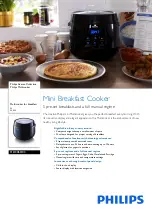
4
Controls and Basic Settings
Power Switch:
The power switch is the upper-right knob on the control panel. It turns stiffly, as it is a
mechanical timer. The on position is fully clockwise, and the off position is fully anticlockwise. Its
primary function is a safety switch; it will automatically switch off the roaster if not manually reset
periodically. The switch can also function as a timer, in which case it operates as follows:
●
9 o'clock: 10 minutes
●
12 o'clock: 20-minutes
●
3 o'clock: 30-minutes
Before charging the roaster with green beans, turn the switch fully on. Alternatively, set it to run for a
little longer than the predicted time for the roast. If the roaster stops during the process, immediately
turn the switch back on.
Heater Control:
The knob at the bottom-left of the control panel steplessly adjusts the heater current
from fully-off to fully-on. As the heaters warm and cool, their resistance changes slightly, which causes
the current to drift away somewhat from the intended setting. Thus, it is necessary to readjust the
electrical current back to the desired setting a few minutes after changing the setting to obtain a precise
heat level.
Ammeter:
The ammeter is on the upper-left of the control panel. It measures the electrical current
flowing through the heaters. Each mark on the meter corresponds to 0.5-Ampere. One can convert the
displayed electrical current to the consumed power with the formula
P=I*E
, where
P
is the power
(watts),
I
is the current intensity (amperes), and
E
is the electromotive force (volts). Alternatively, use
an energy monitor such as a KIll-a-Watt
®
.
Blower Control:
The blower is multi-purpose; it moves air through the roaster, removes chaff from the
roasting chamber, and can cool the roasted beans. The knob at the bottom-right of the control panel
steplessly adjusts the blower level. There are two versions of this control. On some models, the blower
is always on. On other models, the blower stays off from the lowest setting to about 3.8, at which point
it begins to turn. Although the dial has higher graduations, it does not turn past 8.
Thermometer:
The bean temperature displayed on the thermometer is a relative value, not the actual
bean temperature. The BT indicated by thermometers on all roasters varies, mainly depending on the
probe’s placement and the batch size. It is advisable to correlate the displayed temperature to the actual
bean temperature at known points. The appendix contains a table to record corrected values for future
reference. The temperature displayed via the ET port, on the other hand, is accurate.
Circuit Breaker:
The circuit breaker is at the roaster’s back, next to the power cord. It shuts down the
roaster if there is a failure causing an excessive current draw. If the roaster does not operate, reset the
breaker by depressing the button. If the breaker opens again, the roaster needs repair.






































